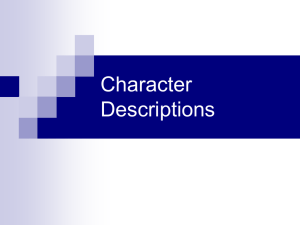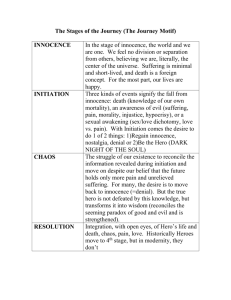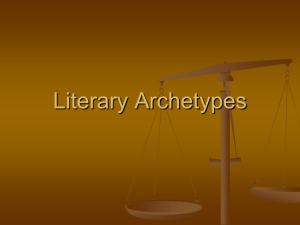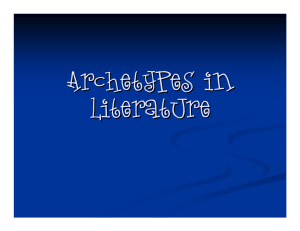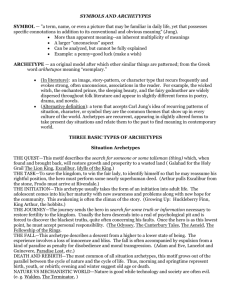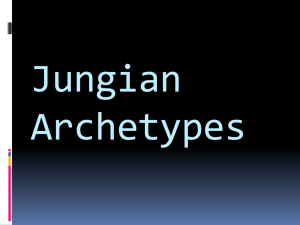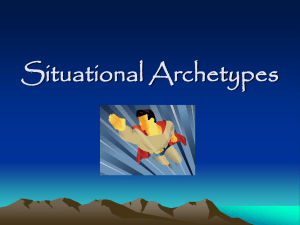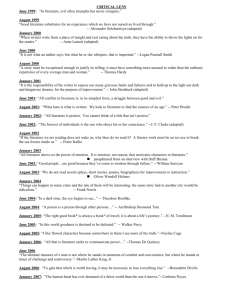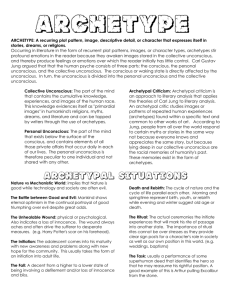Archetypes
advertisement
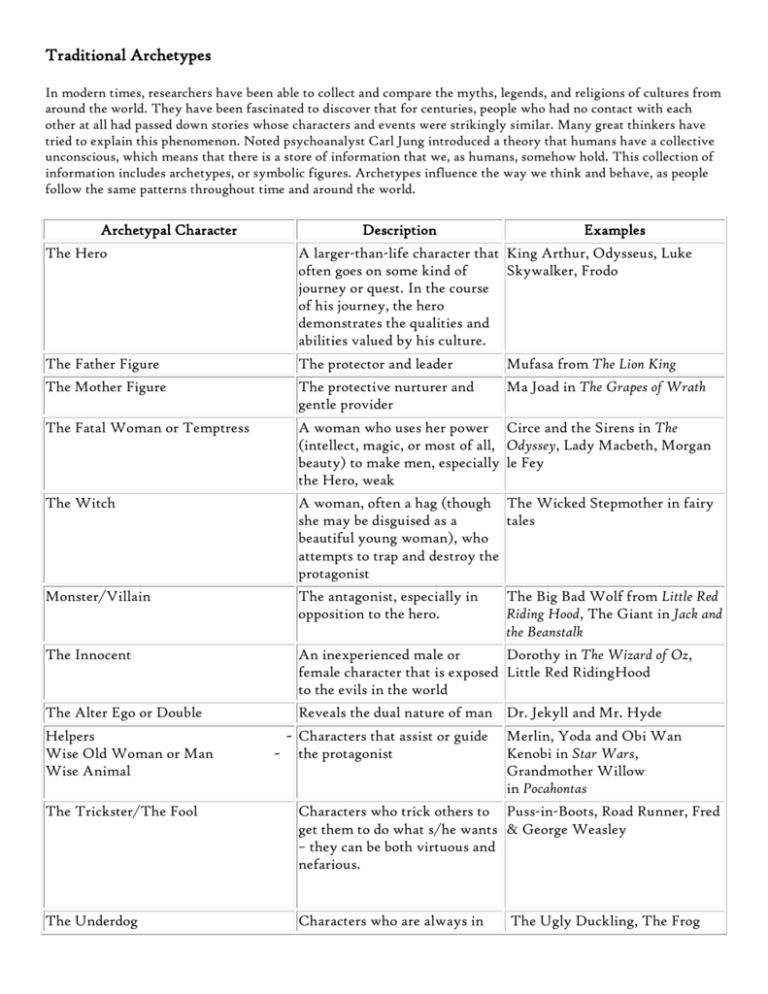
Traditional Archetypes In modern times, researchers have been able to collect and compare the myths, legends, and religions of cultures from around the world. They have been fascinated to discover that for centuries, people who had no contact with each other at all had passed down stories whose characters and events were strikingly similar. Many great thinkers have tried to explain this phenomenon. Noted psychoanalyst Carl Jung introduced a theory that humans have a collective unconscious, which means that there is a store of information that we, as humans, somehow hold. This collection of information includes archetypes, or symbolic figures. Archetypes influence the way we think and behave, as people follow the same patterns throughout time and around the world. Archetypal Character Description Examples The Hero A larger-than-life character that King Arthur, Odysseus, Luke often goes on some kind of Skywalker, Frodo journey or quest. In the course of his journey, the hero demonstrates the qualities and abilities valued by his culture. The Father Figure The protector and leader Mufasa from The Lion King The Mother Figure The protective nurturer and gentle provider Ma Joad in The Grapes of Wrath The Fatal Woman or Temptress A woman who uses her power Circe and the Sirens in The (intellect, magic, or most of all, Odyssey, Lady Macbeth, Morgan beauty) to make men, especially le Fey the Hero, weak The Witch A woman, often a hag (though The Wicked Stepmother in fairy she may be disguised as a tales beautiful young woman), who attempts to trap and destroy the protagonist Monster/Villain The antagonist, especially in opposition to the hero. The Innocent An inexperienced male or Dorothy in The Wizard of Oz, female character that is exposed Little Red RidingHood to the evils in the world The Alter Ego or Double Reveals the dual nature of man Dr. Jekyll and Mr. Hyde Helpers Wise Old Woman or Man Wise Animal ~ Characters that assist or guide ~ the protagonist The Big Bad Wolf from Little Red Riding Hood, The Giant in Jack and the Beanstalk Merlin, Yoda and Obi Wan Kenobi in Star Wars, Grandmother Willow in Pocahontas The Trickster/The Fool Characters who trick others to Puss-in-Boots, Road Runner, Fred get them to do what s/he wants & George Weasley – they can be both virtuous and nefarious. The Underdog Characters who are always in The Ugly Duckling, The Frog the wrong place at the wrong time, but who usually win something of value in the end. Prince, Neville Longbottom Archetypes and Symbols SITUATION ARCHETYPES 1. The Quest – This motif describes the search for someone or some talisman which, when found and brought back, will restore fertility to a wasted land, the desolation of which is mirrored by a leader’s illness and disability. 2. The Task – This refers to a possibly superhuman feat that must be accomplished in order to fulfill the ultimate goal. 3. The Journey – The journey sends the hero in search for some truth of information necessary to restore fertility, justice, and/or harmony to the kingdom. The journey includes the series of trials and tribulations the hero faces along the way. Usually the hero descends into a real or psychological hell and is forced to discover the blackest truths, quite often concerning his faults. Once the hero is at this lowest level, he must accept personal responsibility to return to the world of the living. 4. The Initiation – This situation refers to a moment, usually psychological, in which an individual comes into maturity. He or she gains a new awareness into the nature of circumstances and problems and understands his or her responsibility for trying to resolve the dilemma. Typically, a hero receives a calling, a message or signal that he or she must make sacrifices and become responsible for getting involved in the problem. Often a hero will deny and question the calling and ultimately, in the initiation, will accept responsibility. 5. The Ritual – Not to be confused with the initiation, the ritual refers to an organized ceremony that involves honored members of a given community and an Initiate. This situation officially brings the young man or woman into the realm of the community’s adult world. 6. The Fall – Not to be confused with the awareness in the initiation, this archetype describes a descent in action from a higher to a lower state of being, an experience which might involve defilement, moral imperfection, and/or loss of innocence. This fall is often accompanied by expulsion from a kind of paradise as penalty for disobedience and/or moral transgression. 7. Death and Rebirth – The most common of all situational archetypes, this motif grows out of the parallel between the cycle of nature and the cycle of life. It refers to those situations in which someone or something, concrete and/or metaphysical dies, yet is accompanied by some sign of birth or rebirth. 8. Nature vs. Mechanistic World – Expressed in its simplest form, this refers to situations which suggest that nature is good whereas the forces of technology are bad. 9. Battle Between Good and Evil – These situations pit obvious forces which represent good and evil against one another. Typically, good ultimately triumphs over evil despite great odds. 10. The Unhealable Wound – This wound, physical or psychological, cannot be healed fully. This would also indicate a loss of innocence or purity. Often the wounds’ pain drives the sufferer to desperate measures of madness. 11. The Magic Weapon – Sometimes connected with the task, this refers to a skilled individual hero’s ability to use a piece of technology in order to combat evil, continue a journey, or to prove his or her identity as a chosen individual. 12. Father-Son Conflict – Tension often results from separation during childhood or from an external source when the individuals meet as men and where the mentor often has a higher place in the affections of the hero than the natural parent. Sometimes the conflict is resolved in atonement. 13. Innate Wisdom vs. Educated Stupidity – Some characters exhibit wisdom and understanding intuitively as opposed to those supposedly in charge. SYMBOLIC ARCHETYPES 1. Light vs. Darkness – Light usually suggests hope, renewal, OR intellectual illumination; darkness implies the unknown, ignorance, or despair. 2. Water vs. Desert – Because water is necessary to life and growth, it commonly appears as a birth or rebirth symbol. Water is used in baptism services, which solemnizes spiritual births. Similarly, the appearance of rain in a work of literature can suggest a character’s spiritual birth. 3. Heaven vs. Hell – Humanity has traditionally associated parts of the universe not accessible to it with the dwelling places of the primordial forces that govern its world. The skies and mountaintops house its gods; the bowels of the earth contain the diabolic forces that inhabit its universe. 4. Haven vs. Wilderness – Places of safety contrast sharply against the dangerous wilderness. Heroes are often sheltered for a time to regain health and resources. 5. Supernatural Intervention – The gods intervene on the side of the hero or sometimes against him. 6. Fire vs. Ice – Fire represents knowledge, light, life, and rebirth while ice like desert represents ignorance, darkness, sterility, and death. 7. A. B. C. D. E. F. G. H. I. Colors Black (darkness) – chaos, mystery, the unknown, before existence, death, the unconscious, evil Red – blood, sacrifice; violent passion, disorder, sunrise, birth, fire, emotion, wounds, death, sentiment, mother, Mars, anger, excitement, heat, physical stimulation Green – hope, growth, envy, Earth, fertility, sensation, vegetation, death, water, nature, sympathy, adaptability, growth, Jupiter and Venus, envy White (light) – purity, peace, innocence, goodness, Spirit, morality, creative force, the direction East, spiritual thought Orange – fire, pride, ambition, egoism, Venus Blue – clear sky, the day, the sea, height, depth, heaven, religious feeling, devotion, innocence, truth, spirituality, Jupiter, physical soothing and cooling Violet – water, nostalgia, memory, advanced spirituality, Neptune Gold – Majesty, sun, wealth, corn (life dependency), truth Silver – Moon, wealth 8. Numbers: A. Three – the Trinity (Father, Son, Holy Ghost); Mind, Body, Spirit, Birth, Life, Death B. Four – Mankind (four limbs), four elements, four seasons C. Six – devil, evil D. Seven – Divinity (3) + Mankind (4) = relationship between man and God, seven deadly sins, seven days of week, seven days to create the world, seven stages of civilization, seven colors of the rainbow, seven gifts of Holy Spirit. 9. Nature: A. Air – activity, creativity, breath, light, freedom (liberty), movement B. Ascent – height, transcendence, inward journey, increasing intensity C. Center – thought, unity, timelessness, spacelessness, paradise, creator, infinity, D. Descent – unconscious, potentialities of being, animal nature E. Duality – Yin-Yang, opposites, complements, positive-negative, male-female, life-death F. Earth – passive, feminine, receptive, solid G. Fire – the ability to transform, love, life, health, control, sun, God, passion, spiritual energy, regeneration H. Lake – mystery, depth, unconscious I. Crescent moon – change, transition J. Mountain – height, mass, loftiness, center of the world, ambition, goal K. Valley – depression, low-points, evil, unknown L. Sun – Hero, son of Heaven, knowledge, the Divine eye, fire, life force, creative-guiding force, brightness, splendor, active awakening, healing, resurrection, ultimate wholeness M. Water – passive, feminine N. Rivers/Streams – life force, life cycle O. Stars – guidance P. Wind – Holy Spirit, life, messenger Q. Ice/Snow – coldness, barrenness R. Clouds/Mist – mystery, sacred S. Rain – life giver T. Steam – transformation to the Holy Spirit U. Cave – feminine V. Lightning – intuition, inspiration W. Tree – where we learn, tree of life, tree of knowledge X. Forest – evil, lost, fear 10. A. B. C. D. E. F. G. H. I. J. K. Objects: Feathers – lightness, speed Shadow – our dark side, evil, devil Masks – concealment Boats/Rafts – safe passage Bridge – change, transformation Right hand – rectitude, correctness Left hand – deviousness Feet – stability, freedom Skeleton – mortality Heart – love, emotions Hourglass – the passage of time The following list of patterns comes from the book How to Read Literature Like a Professor by Thomas C. Foster who teaches at the University of Michigan. Trips tend to become quests to discover self. Meals together tend to be acts of communion/community or isolation. Ghosts, vampires, monsters, and nasty people and sometimes simply the antagonists are not about supernatural brew-ha-ha; they tend to depict some sort of exploitation. There’s only one story. Look for allusions and archetypes. Weather matters. Violence and be both literal and figurative. Symbols can be objects, images, events, and actions. Sometimes a story is meant to change us, the readers, and through us change society. Keep an eye out for Christ-figures. Flying tends to represent freedom. What do you think falling represents? Getting dunked or just sprinkled in something wet tends to be a baptism. Geography tends to be a metaphor for the psyche. Seasons tend to be traditional symbols. Disabilities, Scars, and Deformities show character and theme. Heart disease tends to represent problems with character and society. So do illness and disease. Read with your imagination. Irony trumps everything! Remember the difference between public and private symbols
